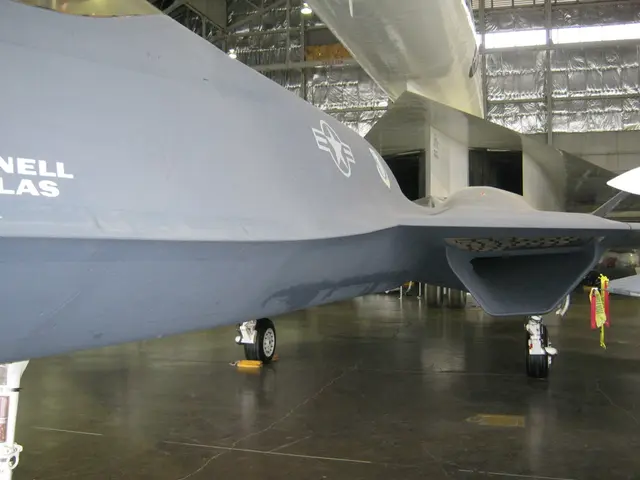Functioning of the Instrument Landing System Explained
In the realm of aviation, the Instrument Landing System (ILS) plays a crucial role in enabling safe and accurate landings in conditions where visibility is poor or the runway environment is not visible until the last moments of approach.
The ILS, a radio navigation system over 90 years old, provides precise guidance to aircraft approaching a runway. It consists of two key components: the localizer and the glideslope. The localizer represents the centre of the localizer course, guiding pilots to align their aircraft with the runway, while the glideslope offers vertical guidance, typically located 750 to 1250 feet down the runway, 400 to 600 feet from the side of the runway's centreline.
In most modern glass-panel aircraft, the localizer and glideslope are represented as a green line or triangle for the localizer, and a green diamond or triangle for the glideslope. Marker beacons, sometimes included in an ILS approach, designate specific positions on the approach.
ILS approaches allow general aviation pilots to land in as little as 1/2 statute mile visibility and as low as 200-foot cloud ceilings. The specific weather minima depend on the ILS category (CAT I, II, III), with CAT II and III approaches allowing even lower minimums, down to zero decision height and very minimal visibility. However, these require specialized pilot certification and aircraft equipment.
Pilots flying ILS must comply with published step-down fixes and minimum altitudes for obstacle clearance, which sometimes require staying above the ILS glide slope until the final approach fix. After intercepting the glideslope during the final approach, a gradual descent is started, typically providing a 3-degree descent to the runway.
The beam of the glideslope is 1.4 degrees thick, with .7 degrees of glidepath projected on either side of the beam. The glideslope works by transmitting 90 Hz and 150 Hz lobes, which are interpreted by the ILS receiver to provide vertical guidance. Localizers, on the other hand, have an adjusted course width of 700 feet at the runway threshold and transmit signals on odd tenths between 108.1 MHz and 111.95 MHz.
As pilots approach the runway, the approach light system (ALS) helps identify the runway environment in low-visibility and transitions from instrument flying to visual flying, aiding with identifying the runway's centreline. The Middle Marker identifies the decision height, the altitude at which the pilot must have visual reference to continue the approach and land; otherwise, a missed approach is executed.
False glideslopes can occur when objects below 5,000 feet AGL reflect glideslope signals, often at 9-degree and 12-degree angles to the runway. This can cause confusion for pilots, emphasising the importance of adhering to published ILS procedures and maintaining vigilance during approaches.
In summary, the Instrument Landing System offers a vital service in aviation, enabling landings in low visibility and low cloud ceiling conditions below normal visual flight rules minimums. With specific weather minima defined by the ILS category and published approach plate procedures, the ILS protects pilots during poor weather by providing instrument guidance close to the runway threshold where visual cues are minimal or unavailable.
- The Instrument Landing System (ILS), a radio navigation system, provides precise guidance to aircraft approaching a runway during aviation, guiding them with the localizer and glideslope.
- In modern glass-panel aircraft, the localizer and glideslope are represented as a green line or triangle for the localizer and a green diamond or triangle for the glideslope.
- The localizer, a key component of the ILS, represents the centre of the localizer course, guiding pilots to align their aircraft with the runway, while the glideslope offers vertical guidance.
- As pilots approach the runway, they must comply with published step-down fixes and minimum altitudes for obstacle clearance, and sometimes need to stay above the ILS glide slope until the final approach fix.
- The ILS allows general aviation pilots to land in as little as 1/2 statute mile visibility and as low as 200-foot cloud ceilings, but this requires specialized pilot certification and aircraft equipment.
- The specific weather minima depend on the ILS category (CAT I, II, III), with CAT II and III approaches allowing even lower minimums, down to zero decision height and very minimal visibility.
- As they approach the runway, the approach light system (ALS) helps identify the runway environment in low-visibility and transitions from instrument flying to visual flying.
- The beam of the glideslope is 1.4 degrees thick and works by transmitting 90 Hz and 150 Hz lobes, which are interpreted by the ILS receiver to provide vertical guidance.
- In the industry, the finance, technology, and aerospace sectors have contributed significantly to the advancement of the ILS and other aviation navigation systems.
- Understanding and adhering to ILS procedures during poor weather conditions is crucial for pilots to ensure safe and accurate landings, as false glideslopes can occur due to objects reflecting glideslope signals.








